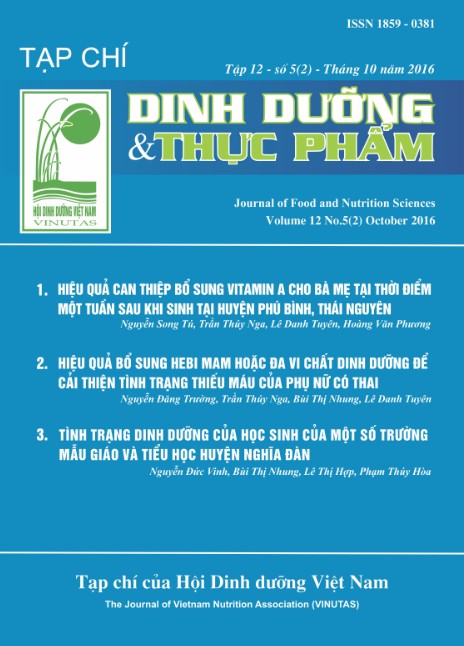THE EFFECTIVENESS OF VITAMIN A SUPPLEMENTATION IN POSTPARTUM MOTHERS AFTER ONE WEEK DELIEVERY TO BREASTMILK RETINOL STATUS
Main Article Content
Abstract
Vitamin A deficiency is still a worldwide public health issue in Vietnam. To be able to
provide future recommendations on the timing of interventions, and to contribute to the
theories and practices of vitamin A supplementation for lactating mothers, we evaluated
the effectiveness of a high dose vitamin A supplementation within the first week after
delievery on breask milk retinol status during a 6 week periode. A randomized doubleblind community-based trial was conducted on 337 postpartum mothers. The results
showed that a high dose vitamin A (200.000 IU) supplementation in the first week after
birth improved breask milk retinol status on the second week after birth (p <0.05); while
the supplementation had no effect by the 4th and 6th week. Vitamin A supplementation in
the first week after delivery proved not to be the right time to ensure a long-term and efficiency improvement of breast milk retinol status. Therefore, the study recommends that
more reasearch is needed to find a more appropriate time to intervene, to increase the effectiveness of high-dose vitamin A supplementation for lactating women.
Keywords
Retinol, beast mikd, vitamin A supplementation efficiency
Article Details
References
2. Tchum SK, Newton S, de Benoist B, Owusu-Agyei S, Arthur FK, et al (2006), Evaluation of vitamin A supplementation regimens in Ghanaian postpartum mothers with the use of the modified-relativedose-response test. Am J Clin Nutr, p.84(6):1344-9.
3. Amy Rice, Rebecca J Stoltzfus, Andres de Francisco, and Chris L Kjolhede (2000). Evaluation of serum retinol, the modifiedrelative-dose-response ratio, and breastmilk vitamin A as indicators of response to postpartum maternal vitamin A supplementation. Am J Clin Nutr, (71): p. 799–806.
4. Ayah RA, Mwaniki DL, Magnussen P and al (2007). The effects of maternal and infant supplementation on vitamin A status: a randomized trial in Kenya. British Journal of Nutrition, 98: p. 422–30.
5. WHO (1996). Indicators for assessing vitamin A deficiency and their application in monitoring and evaluating intervention programmes.
6. Idindili B, Masanja H, Urassa H, Wilbert B and al (2007). Randomized controlled safety and efficacy trial of 2 vitamin A supplementation schedules in Tanzanian infants. Am J Clin Nutr. 85: p. 1312-9.
7. Bezerra DS, Araújo KF, Azevêdo GM, Dimenstein R (2009). Maternal supplementation with retinyl palmitate during immediate postpartum period: potential consumption by infant. Rev Saude Publica. 43(4): p. 572-9.
8. Martins TM, Ferraz IS, Daneluzzi JC, Martinelli CE and al (2010). Impact of maternal vitamin A supplementation on the mother-infant pair in Brazil. Eur J Clin Nutr, 64: p. 1302-1307.
9. Tomiya MT, Arruda IK, SilvaDinizA, Santana RA and al (2015). The effect of vitamin A supplementation with 400 000 IU vs 200 000 IU on retinol concentrations in the breast milk: A randomized clinical trial. Clin Nutr, S0261-5614(15): p. 344-351.
10.Rajiv Bahl, Nita Bhandari, Mohammed A. Wahed, Geeta T. Kumar, Maharaj K. Bhan (2002). Vitamin A supplementation of women postpartum and of their infants at immunization afters breast milk retinol
and infant vitamin A status. The Journal of Nutrition, p. 3243-7.
11.Wieringa FT, West CE, Northrop-Clewes CA, Muhilal (2002). Estimation of the effect of the acute phase response on indicators of micronutrient status in Indonesian infants. J Nutr 2002, 132: p3061-3066.
12.Van Lettow M, van der Meer JW, Wieringa FT, Semba RD (2005). Low plasma selenium concentrations, high
plasma human immunodeficiency virus load and high interleukin-6 concentrations are risk factors associated with anemia in adults presenting with pulmonary tuberculosis in Zomba district, Malawi. Eur J Clin Nutr, 59(4): p. 526-532.
13.Friis H, Kaondera K, Sandstram B, Michaelsen KF, Vennervald BJ et al. (1996). Serum concentration of micronutrients in relation to schistosomiasis and indicators of infection: a cross-sectional study among rural Zimbabwean schoolchildren. Eur J Clin Nutr, 50(6): p. 386-391.


